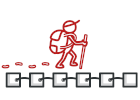
파이썬으로 작성된 반복자
반복자는 복잡한 데이터 구조의 내부 세부 정보를 노출하지 않고 해당 구조를 차례대로 순회할 수 있도록 하는 행동 디자인 패턴입니다.
반복자 덕분에 클라이언트들은 단일 반복기 인터페이스를 사용하여 유사한 방식으로 다른 컬렉션들의 요소들을 탐색할 수 있습니다.
복잡도:
인기도:
사용 예시들: 이 패턴은 파이썬 코드에 자주 사용됩니다. 많은 프레임워크들과 라이브러리들은 이 패턴을 컬렉션을 순회하는 표준 방법을 제공하기 위해 사용합니다.
식별법: 반복자는 그의 탐색 메서드들(예: next, previous 등)로 쉽게 인식할 수 있습니다. 또 반복자를 사용하는 클라이언트 코드는 반복자가 순회하는 컬렉션을 직접 접근하지 못할 수도 있습니다.
개념적인 예시
이 예시는 반복자 디자인 패턴의 구조를 보여주고 다음 질문에 중점을 둡니다:
- 패턴은 어떤 클래스들로 구성되어 있나요?
- 이 클래스들은 어떤 역할을 하나요?
- 패턴의 요소들은 어떻게 서로 연관되어 있나요?
main.py: 개념적인 예시
from __future__ import annotations
from collections.abc import Iterable, Iterator
from typing import Any
"""
To create an iterator in Python, there are two abstract classes from the built-
in `collections` module - Iterable,Iterator. We need to implement the
`__iter__()` method in the iterated object (collection), and the `__next__ ()`
method in theiterator.
"""
class AlphabeticalOrderIterator(Iterator):
"""
Concrete Iterators implement various traversal algorithms. These classes
store the current traversal position at all times.
"""
"""
`_position` attribute stores the current traversal position. An iterator may
have a lot of other fields for storing iteration state, especially when it
is supposed to work with a particular kind of collection.
"""
_position: int = None
"""
This attribute indicates the traversal direction.
"""
_reverse: bool = False
def __init__(self, collection: WordsCollection, reverse: bool = False) -> None:
self._collection = collection
self._reverse = reverse
self._sorted_items = None # Will be set on first __next__ call
self._position = 0
def __next__(self) -> Any:
"""
Optimization: sorting happens only when the first items is actually
requested.
"""
if self._sorted_items is None:
self._sorted_items = sorted(self._collection._collection)
if self._reverse:
self._sorted_items = list(reversed(self._sorted_items))
"""
The __next__() method must return the next item in the sequence. On
reaching the end, and in subsequent calls, it must raise StopIteration.
"""
if self._position >= len(self._sorted_items):
raise StopIteration()
value = self._sorted_items[self._position]
self._position += 1
return value
class WordsCollection(Iterable):
"""
Concrete Collections provide one or several methods for retrieving fresh
iterator instances, compatible with the collection class.
"""
def __init__(self, collection: list[Any] | None = None) -> None:
self._collection = collection or []
def __getitem__(self, index: int) -> Any:
return self._collection[index]
def __iter__(self) -> AlphabeticalOrderIterator:
"""
The __iter__() method returns the iterator object itself, by default we
return the iterator in ascending order.
"""
return AlphabeticalOrderIterator(self)
def get_reverse_iterator(self) -> AlphabeticalOrderIterator:
return AlphabeticalOrderIterator(self, True)
def add_item(self, item: Any) -> None:
self._collection.append(item)
if __name__ == "__main__":
# The client code may or may not know about the Concrete Iterator or
# Collection classes, depending on the level of indirection you want to keep
# in your program.
collection = WordsCollection()
collection.add_item("B")
collection.add_item("A")
collection.add_item("C")
print("Straight traversal:")
print("\n".join(collection))
print("")
print("Reverse traversal:")
print("\n".join(collection.get_reverse_iterator()), end="")
Output.txt: 실행 결과
Straight traversal:
A
B
C
Reverse traversal:
C
B
A
 겨울 세일!
겨울 세일!
